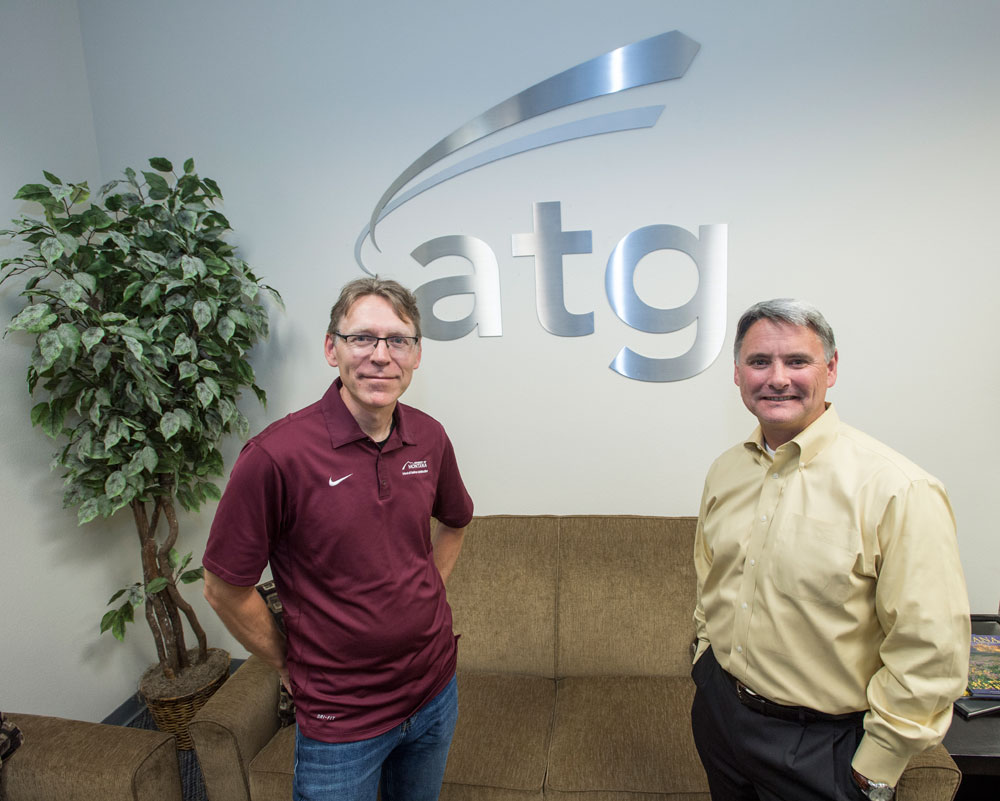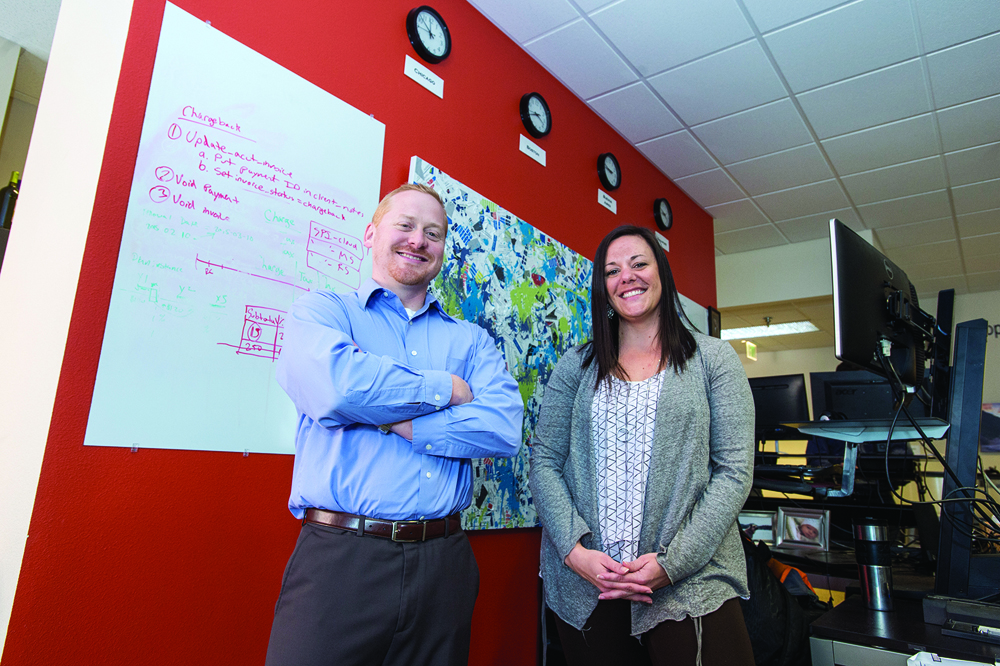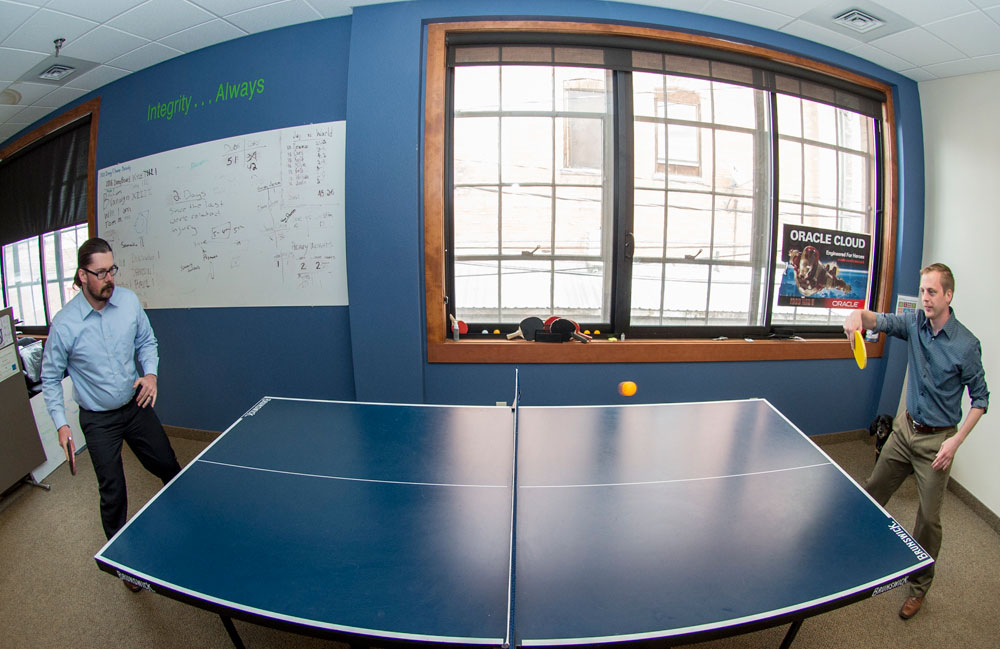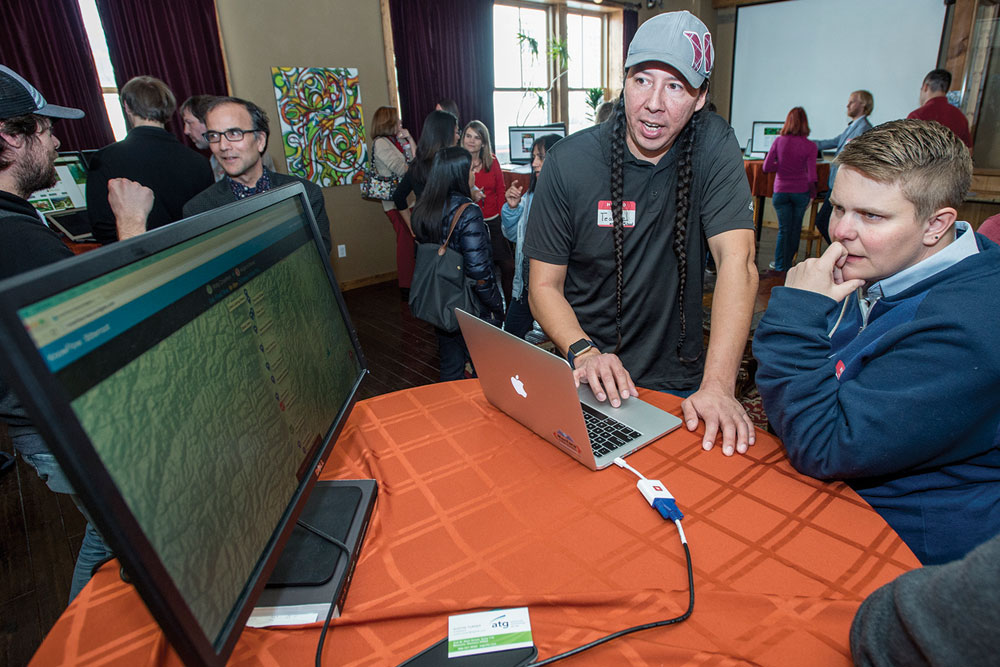- Editorial Offices
- 325 Brantly Hall
- Missoula, MT 59812
- (406) 243-2488
- themontanan@umontana.edu
- Icons By Maria Maldonado
UM partners with growing high-tech sector to create high-paying jobs, keep talented graduates right here in Montana





In the past six months, Jorge Watson has traveled to Australia, San Francisco, Boston, and New York City. During his visit to Boston, Watson met with the CEO and executive team of a well-known, publicly traded company to help with a multimillion-dollar business integration project. After three days there, Watson hopped on a train to New York City, where he met with executives from the acquired company in Manhattan.
“As I’m sitting there meeting with the executives, I notice that I can look out and see the Statue of Liberty,” Watson says. “Being from Montana and going to the heart of these massive commerce hubs to work with executives in organizations that are going through a high-profile merger is not something I expected coming out of the University of Montana—at least not this early in my career.”
When Watson was a student at UM’s School of Business Administration, he knew he wanted to go into the fast-paced world of technology, but he always thought he would have to trade the Missoula Valley for the Silicon Valley to find a job. That was until he met David Firth, UM professor of Management Information Systems, and Tom Stergios, vice president of Advanced Technology Group Missoula Solutions Center.
A 2011 graduate of the Management Information Systems program, Watson interviewed with two of the “Big Four” consultancy firms, but he didn’t want to leave Montana to live in Los Angeles, Atlanta, or another big city. In Firth’s consulting class, he learned about an opportunity in the heart of downtown Missoula to be part of a dynamic team that works with an impressive list of companies throughout the world.
Stergios, a guest lecturer in Firth’s class, told students about the consulting work his company—ATG—was doing from its Missoula office, including managing complex revenue and customer interaction processes for Fortune 1,000 companies that have annual revenues ranging from $160 million to $16 billion. He told them ATG’s clients include some of the fastest growing companies—CenturyLink, Atlassian, Sungard, Yodle, Concur, Constant Contact, InterCall, and many others. Watson immediately was interested.
He has been with ATG a little over four years, moving quickly up the ranks and becoming the director of solution delivery.
ATG has grown rapidly since it opened the Missoula office with a couple of employees in 2011. Of the seventy-plus workers today, more than half are fairly recent UM graduates. Located on Missoula’s Main Street in the historic Studebaker Building, ATG is a high-tech firm with headquarters in Kansas City, Kan., and offices in Denver, Cincinnati, St. Louis, Dallas, and Missoula, which is now the largest.
ATG consultants are paid well. The average consultant salary is more than $75,000, with entry-level positions starting in the low-$40,000 range plus bonuses. Senior consultants routinely earn well over $100,000.
In all corners of Big Sky Country, high-tech companies such as ATG are doing business with multinational corporations. It wasn’t too long ago that UM graduates looking for information technology jobs with competitive salaries had to leave the state. As Montana increases its footprint in high-tech businesses, more job opportunities become available, reversing the trend of talented graduates leaving.
According to a 2016 survey conducted by UM’s Bureau of Business and Economic Research for the Montana High Tech Business Alliance, the high-tech industry is growing at rates seven times that of the statewide economy, with average annual salaries at $57,000—more than twice the median earning per Montana worker.
The survey found that Montana’s quality of life provides advantages to doing business in the state, but attracting talent and hiring skilled technology workers is an impediment to growth. A number of efforts are underway to address workforce shortages, and UM has been at the forefront, partnering with the community to enhance workforce development and better meet businesses’ needs.
This fall, the School of Business Administration will help meet a growing workforce need when it launches its new master’s degree in business analytics. The curriculum will include the study of business intelligence, big data analysis, business statistics, and communicating insights based on data analysis. The Montana Code School, located on the UM campus, just graduated its second class of students from the twelve-week, bootcamp-style course. The school teaches students the skills to enter junior-level programming positions, which are in high demand in the tech sector [see sidebar].
“In the past five years, there has been a conscious effort on behalf of the University to find more innovative ways to engage with the private sector,” says Joe Fanguy, UM director of technology transfer and president of the Montana Technology Enterprise Center [MonTEC]. “Out of that push has come opportunities that may not have surfaced otherwise. People are coming forward with creative ideas.”
Under Fanguy’s leadership, UM works to foster innovation and entrepreneurship and has many success stories of helping UM graduates and faculty start high-tech companies such as Submittable and Agile Data Solutions [see sidebar]. MonTEC, UM’s business and technology incubator, houses ten startup companies, with more than 100 employees, and has ten affiliate members.
Christina Henderson, executive director of the Montana High Tech Business Alliance, a statewide organization of more than 250 tech companies, says a priority is to get word out to students and alumni that there are more high-paying tech jobs in Montana than ever before.
“Our members plan to create 940 new jobs in 2016,” Henderson says. “Yet when I tell students about a dozen Montana companies that are hiring, they have typically only heard of two or three. We need more top graduates to consider career opportunities in Montana.”
A look at five Missoula tech companies with UM ties
Joel Henry, UM professor of computer science and adjunct professor of law, co-founded the company in 2013 to help lawyers sift through legal data. The data-mining software he built lowers the time and cost of searching, reviewing, and categorizing electronic data. Henry’s client base has expanded from bar associations across the U.S. to the oil and gas industry and the FBI.
In 2013, Paige Williams launched the Audience Awards, an online community that provides opportunities for filmmakers, entrepreneurs, and photographers. The platform hosts video contests and provides visibility for brands and filmmakers. Entrepreneur, Forbes, and Inc. magazines recently recognized Audience Awards for its innovative platform. Williams is a UM graduate with an M.F.A. in media arts and a master’s degree in theater directing.
This company’s work in health care data analytics helps employers identify potential risk, apply early intervention, and improve their employees’ health while cutting health care costs. DataSmart partners with major institutions such as Johns Hopkins. Bernard Khomenko is the vice president and has a master of accountancy degree from UM.
Nearly forty years ago, EDULOG created the first routing and scheduling software for school districts. With more than 150,000 school buses routed by its clients each day, EDULOG’s innovative software helps students throughout the world get to school. Jason Corbally, a UM graduate of the School of Business Administration, is EDULOG’s president. EDULOG has 130-plus employees.
A graduate of UM’s Creative Writing Program, Michael FitzGerald created an online submission management software company, which allows organizations to accept, manage, and review different types of content online, from resumes to creative visual or audio files. The company has 4,800 customers across twenty-three countries and has raised $1.3 million in venture capital funding, a rare feat for a Montana-based tech company.
Through a partnership with UM, ATG has recruited and hired more than forty business school graduates and several computer science graduates in the past several years. The UM/ATG partnership began more than six years ago when Stergios and Firth got together for a cup of coffee. Stergios was looking to hire information systems consultants, and Firth was watching as the Big Four consulting firms hired and plucked bright, talented UM graduates out of state when he knew some of them would rather stay in Missoula. Together, they came up with the idea to connect UM and ATG.
For the past three years, Firth takes his students to visit ATG. Once a semester, up to seventy-five students from the business school and the Montana Information Systems Association head to the downtown office for the afternoon to see whiteboarding and flip-charting in action and learn how information technology consultants at ATG spend their days. After the presentation, students are invited to stay and network at “Club MSC” and learn about the “work hard, play hard” company culture.
“Sometimes it’s hard for students to see outside the classroom,” Firth says. “It’s easy to get caught up in homework, intramural sports, and volunteer activities. Visiting a technology company can be transformative.”
ATG has a visible presence on campus, in classrooms, on advisory boards, and at career networking events.
“It’s a great partnership where ATG recruits the best and the brightest from UM,” Firth says. “It’s impressive that our students are delivering world-class consulting to national and international clients. It’s a beautiful situation where our truly gifted students get to do this work right here in town rather than leaving.”
Work-life balance is a top priority at ATG, where employees must be prepared to work across multiple time zones in an industry that is highly competitive and constantly changing.
ATG employees are situated in a cubicle-free, shared space with a refrigerator that is well-stocked with healthy snacks and Rockstar energy drinks. They have ping-pong tournaments during breaks and “walk-and-talk” meetings along the Clark Fork River. Every week, the “Kitchen Czar”—a rotating position—is given a budget and is responsible for stocking the refrigerator with snacks and hosting Friday’s “Club MSC,” where employees unwind with a Moose Drool or similar beverage and share highlights of their weeks. The Rockstar—a can of Rockstar that is spray-painted silver—is awarded each Friday to someone who has done something above and beyond at ATG during the week.
In order to balance family needs, employees may work from home or remotely if needed. Employees’ children are welcome at the office, and so are dogs. In fact, Hercules, a golden retriever, has become an office fixture.
Word about the company’s positive work environment has spread. Last fall, U.S. Secretary of Labor Thomas Perez selected ATG to host a National Work and Families Month Roundtable discussion. Perez and his entourage joined a group of about twenty-five people from local businesses and nonprofits at the roundtable.
“Here at ATG, they’ve created a corporate culture of inclusion and opportunity for people that’s remarkable,” Perez says.
Montana Code School helps build the tech pipeline
For high-tech companies like ATG, the demand for tech workers is growing at an incredibly fast pace. Montana companies are looking to hire programmers and developers for jobs averaging annual salaries of $75,000 but are struggling to find talent, according to Paul Gladen, director of UM’s Blackstone LaunchPad. That’s why Gladen helped co-found the Montana Code School, which aims to expand the pipeline of programming talent available to Montana businesses by training junior programmers with little or no coding experience for high-paying jobs in the tech sector.
Based at UM, the Montana Code School so far has graduated two classes from its twelve-week, intensive computer coding bootcamp program. With eleven students graduating in the first cohort and thirteen in the second, the school already has placed a number of them with tech companies. One of the graduates from the first cohort is Kelly Nash, who recently was hired as the Montana Code School’s first executive director. Nash works with companies throughout the state to address their technology needs and help place graduates in jobs.
Students come from a variety of backgrounds, and some are in the midst of career changes. Diversity is important at the school.
“It’s gratifying working with women, Native Americans, and veterans as they are traditionally underrepresented in programming jobs,” she says.
“A lot of people want to stay in Montana and earn a livable wage,” Nash says. “Attending the Montana Code School can be an on-ramp to a tech job with a good salary and will address workforce shortages and enable businesses to continue to locate in Montana.”
The Montana Code School will expand to Bozeman this summer.

For Kristin Mickey and others at ATG, workplace flexibility is very important. Twice a week, Mickey leaves work a little early to take her sons—ages eight and ten—to karate and swimming lessons. The flexibility allows her to balance her family and her job.
“Tom always gives me grief about not seeing my kids enough,” Mickey says with a laugh. “He always says that we need more kids and dogs around here.”
Mickey started working at ATG while a student at UM and recently was promoted to knowledge management coordinator, a corporate-level position responsible for facilitating learning in all of ATG’s offices.
A 2014 UM graduate from the Management Information Systems program, Mickey’s pathway was not traditional. When she graduated from high school in 2000, she wasn’t sure what she wanted to do, so she waited tables, then found an office job. Soon after, she met her husband and quit her job when their first baby was born. After a two-year break to stay at home with their kids, she took a job at a lumber mill.
When the economy got volatile in 2008, Mickey enrolled at UM. It was in Professor Firth’s class where she first heard about ATG, and she wrote it down in her notebook. In 2013, she started there part time.
Mickey’s rise to a corporate-level job in a tech company is particularly noteworthy because there are far fewer women in the tech industry than men. While women represent nearly half of the total U.S. labor force, they only make up around one-third of the workforce in tech, according to the U.S. Census Bureau. In Montana, a number of initiatives are in the works to attract, retain, and advance talented women in high tech. The top graduates from the inaugural Montana Code School were women with multiple job offers.
While men do outnumber women at ATG, Mickey says that the women are “some of our most influential and impactful leaders and my strongest mentors.”
When Jason Anderson, manager of delivery services at ATG, graduated from the Management Information Systems program in 2009, there weren’t as many tech companies as today. At that point, Stergios had not yet opened the Missoula office and worked from his basement for Kansas-based ATG.
Before graduation, Anderson had interviewed with the Big Four consulting firms, where only top-tier students get job offers, but, like Jorge Watson, he knew he didn’t want to live in a big city.
“I had to do what was right for me and the girl I was going to marry,” Anderson says. “She said, ‘I’m not moving to L.A. I grew up at a dead end of a dirt road.’”
When he got an offer from PricewaterhouseCoopers, a Big Four firm in Portland, Ore., he and his soon-to-be wife—a native of Bigfork—decided to accept it. For nearly four years, Anderson was employed at PwC. While it was a great job, he had a demanding travel schedule, limiting his time with his two young daughters and wife. And he missed the fishing, the hockey at Missoula’s Glacier Ice Rink, and the mountains.
While in Portland, Anderson kept his connections in Montana. On Dean Larry Gianchetta’s Management Information Systems Advisory Board, he came back to Montana twice a year for meetings and the annual Griz/Cat football game. All the while, he looked for job opportunities in Montana because he knew he eventually wanted to return home.
When his wife’s brother was diagnosed with cancer—and died seven months later, leaving his three young nephews and sister-in-law behind—Anderson decided it was time to come home.
“This hit us pretty hard,” Anderson says. “Family was at the forefront of my mind.”
On one of Anderson’s trips to Missoula, he visited with his former professor, Firth, who connected him with ATG’s vice president, Stergios. In spring 2013, Anderson accepted a job at ATG.
He feels fortunate to be able to do world-class consulting work from Montana. Getting off the busy interstates is a relief, and the quality of life is much better, he says. The short commute from his home in Lolo is much better than commuting in Portland—and much more scenic.
“Instead of passing convenience stores, I’m passing bison.”